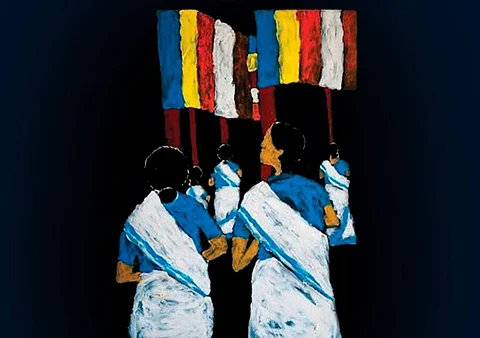

Jyoti Nisha sets the context for her documentary Dr BR Ambedkar: Now & Then right at the beginning, by telling us how the current state of Indian cinema is a reflection and reproduction of the state apparatus. She then dives into how Indian cinema has so far operated from a Brahminical gaze, in which the Bahujan is sometimes a subject, but only to be subjected to Brahminical appropriation, rejection, or victimisation. With statistical data, the film explains in detail how the lack of Dalit-Bahujan representation in the media has contributed to this trend.
The documentary traces this lack of representation and savarna indifference back to the time when Ambedkar had to start his own newspaper Mooknayak in 1920, and how Bal Gangadhar Tilak’s paper Kesari refused to publish a paid advertisement about Mooknayak. Similar obstacles exist even now, as was the case then.
Within this broad framework, the film movingly showcases incidents of caste violence such as the 2016 institutional murder of Rohit Vemula, the public flogging of four Dalit men in Una in the same year for lawfully transporting meat, and the emergence of the Bhim Army as a local force of solidarity and protection while the Thakurs were unleashing violent attacks against the Dalits in Saharanpur in 2017. The film also touches upon the Jack Dorsey incident of 2018, when a picture of the then Twitter CEO, holding a placard saying “smash Brahminical patriarchy” during a closed-door Twitter group session in India, triggered a massive controversy.
The film connects all of these incidents in the ‘now’ to the ‘then’, by referring to the story of Eklavya from the Mahabharata. When the tribal man approached Dronacharya with a desire to learn archery from him, he was mocked and sent away due to his status outside the Hindu varnas. Later, when Dronacharya found out that Eklavya had managed to learn and ace the craft on his own just by observing him, he asked for his thumb as ‘guru dakshina’, i.e. his fee, for the training he never gave to Eklavya. The ‘guru’ merely wanted to ensure that the image of Arjuna, a ‘Kshatriya’ prince, as the superior archer remained intact.
Jyoti, while delving into contemporary issues concerning caste and gender, analyses the origins of Brahminical patriarchy by referring to the Purusha Suktam of the Rig Veda, which is considered the origin of all hierarchies in Indian society. In the ‘now’, there appears to be a deep sense of realisation of this barbaric past. The filmmaker makes this evident by highlighting the forms of protest and resistance that were employed in the wake of the recent incidents of caste violence mentioned above.
One such common mode of resistance is the use of the Buddhist flag. For the Dalit-Bahujan masses, this flag is not simply a representation of Buddhism or of Ambedkar’s conversion to Buddhism in 1956. Instead, it is symbolic of the ancient conflict between Brahminism and Buddhism, which essentially attacked caste.
The other common method of resistance is the use of the Constitution, which is also not simply a representation of a recent post-colonial India. From the Dalit-Bahujan gaze, the document is an antithesis of the governing law of ancient India, i.e., the Manusmriti, which subjugated them for centuries. Let it be recalled that Dr Ambedkar too insisted on pursuing Dalit struggles through legal channels, as opposed to the Gandhian methods of civil disobedience or fasting unto death.
In the film, Jyoti is thus reversing the Brahminical gaze at multiple levels by making this film from a Dalit-Bahujan standpoint, even bringing the stories of her own family’s resistance into the picture. She neatly depicts how the reversal of gaze occurs in contemporary Dalit assertions today — mainly through the rejection of Brahminical symbols, theories, metaphysics, religion, or anything else under the sun, and the acceptance of non-Brahminical symbols such as the Buddhist flag and the Constitution of India.
The documentary also succeeds in making a dent in the non-inclusive Brahminical media structure, which has been and still is the major source of production of popular culture. This structure is inherently indifferent to spaces of Dalit assertion, and is hence consequently apathetic towards any representation of such assertions as well. As a corollary, the Dalit-Bahujan masses, who are greater in number, have been the passive receivers of such limiting Brahminical imagination. The film is a breath of fresh air, as it actively engages with Ambedkar and portrays him as a civilising force in a deeply casteist society, now and then.
Dr BR Ambedkar: Now & Then was recently screened at the Bangalore International Centre.
Watch the trailer here:
Dr Ashna Singh is an assistant professor of law at the National Law School of India University, Bengaluru.